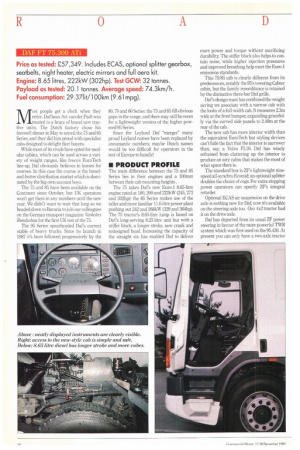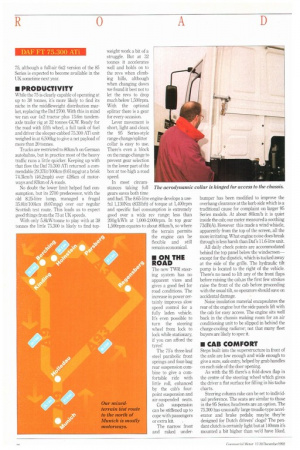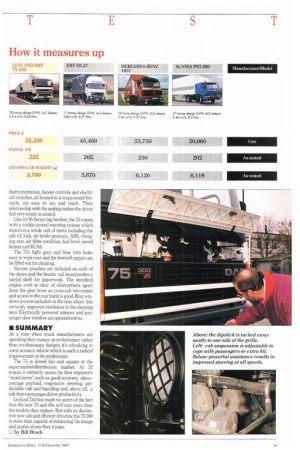DAF FT 75.300 ATi
Page 28

Page 30

Page 31

If you've noticed an error in this article please click here to report it so we can fix it.
Price as tested: £57,349. Includes ECAS, optional splitter gearbox, seatbelts, night heater, electric mirrors and full aero kit. Engine: 8.65 litres, 222kW (302hp). Test GCW: 32 tonnes. Payload as tested: 20.1 tonnes. Average speed: 74.3km/h. Fuel consumption: 29.3714/100km (9.61mpg).
Most people get a clock when they retire. Daf boss Art van der Pack was treated to a brace of brand new tractive units. The Dutch factory chose his farewell dinner in May to unveil the 75 and 85 Series, and they did him proud with specialist cabs designed to delight fleet buyers.
While most of its rivals have opted for modular cabins, which can be used across a variety of weight ranges, like Iveco's EuroTech line-up, Daf obviously believes in horses for courses, In this case the course is the breadand-butter distribution market which is dominated by the big own-account boys.
The 75 and 85 have been available on the Continent since October, but UK operators won't get them in any numbers until the new year. We didn't want to wait that long so we headed down to Bavaria to join our colleagues on the German transport magazine Verkehrs Rundschau for the first UK test of the 75.
The 95 Series spearheaded Daf's current stable of heavy trucks. Since its launch in 1987 it's been followed progressively by the 80, 70 and 60 Series: the 75 and 85 fill obvious gaps in the range, and there may still be room for a lightweight version of the higher powered 95 Series.
Since the Leyland Daf "merger" many proud Leyland names have been replaced by unromantic numbers; maybe Dutch names would be too difficult for operators in the rest of Europe to handle!
• PRODUCT PROFILE
The main difference between the 75 and 85 Series lies in their engines and a 100mm between their cab mounting heights The 75 takes Oaf's new Euro.1 8.65-litre engine rated at 180, 200 and 222kW (245, 272 and 302hp): the 85 Series makes use of the taller and more familiar 11.6-litre power plant pushing out 242 and 268kW (329 and 364hp). The 75 tractor's 8.65-litre lump is based on Daf's long-serving 8.25-litre unit but with a stiffer block, a longer stroke, new crank and redesigned head. Increasing the rapacity of the straight six has enabled Daf to deliver more power and torque without sacrificing durability. The stiffer block also helps to contain noise, while higher injection pressures and improved breathing help meet the Euro-1 emissions standards.
This 75/85 cab is clearly different from its predecessors, notably the 95's towering Cabtec cabin, but the family resemblance is retained by the distinctive three-bar Daf grille.
Oaf's design team has combined the weight saving we associate with a narrow cab with the looks of a full-width cab. It measures 2.3m wide at the front bumper, expanding gracefully via the curved side panels to 2.49m at the rear of the cab.
The new cab has more interior width than the equivalent EuroTech but styling devices can't hide the fact that the interior is narrower than, say, a Volvo ELIO. Daf has wisely refrained from cluttering up the interior to produce an airy cabin that makes the most of what space there is.
The standard box is ZF's lightweight ninespeed all-synchro Ecomid; an optional splitter doubles the choice of cogs. For extra stopping power operators can specify ZF's integral retarder.
Optional ECAS air suspension on the drive axle is nothing new for Daf; now it's available on the steering-axle too. Our 4x2 tractor had it on the drive axle.
Daf has departed from its usual ZF power steering in favour of the more powerful TWR system which was first used on the 95.430. At present you can only have a two-axle tractor 75, although a full-air 6x2 version of the 85 Series is expected to become available in the UK sometime next year.
• PRODUCTIVITY
While the 75 is clearly capable of operating at up to 38 tonnes, it's more likely to find its niche in the middleweight distribution market, replacing the Daf 2700. With this in mind we ran our 4x2 tractor plus 13.6m tandemaxle trailer rig at 32 tonnes GCW. Ready for the road with fifth wheel, a full tank of fuel and driver the sleeper-cabbed 75.300 ATi unit weighed in at 6,500kg to give a net payload of more than 20 tonnes.
Trucks are restricted to 80Iun/h on German autobahns, but in practice most of the heavy traffic runs a little quicker. Keeping up with that flow the Daf 75.300 ATi returned a commendable 29.371it/100km (9.61mpg) at a brisk 74.3km/h (46.2mph) over 428km of motorways and 83km of A-roads.
No doubt the lower limit helped fuel consumption, but its 2700 predecessor, with the old 8.25-litre lump, managed a frugal 35.01it/100km (8.07mpg) over our regular Scottish test route. This leads us to expect good things from the 75 at UK speeds.
With only 5.8kW/tonne to play with at 38 tonnes the little 75.300 is likely to find top
weight work a bit of a struggle. But at 32 tonnes it accelerates well and holds on to the revs when climbing hills, although when changing down we found it best not to let the revs to drop much below 1,500rpm. With the optional splitter there is a gear for every occasion.
Lever movement is short, light and clean; the 95 Series-style range-change/splitter collar is easy to use. There's even a block on the range-change to prevent gear selection in the lower part of the box at too high a road speed.
In most circumstances taking full gears saves both time and fuel. The 8.65-litre engine develops a useful 1,130Nm (8331bft) of torque at 1,400rpm and specific fuel consumption is extremely good over a wide rev range: less than 200g/kWh at 1,000-2,000rpm. In top gear 1,500rpm equates to about 80Iun/h, so where the terrain permits the engine can be flexible and still remain economical.
• ON THE ROAD
The new TWR steering system has no apparent vices and gives a good feel for road conditions. The increase in power certainly improves slow speed control for a fully laden vehicle. It's even possible to turn the steering wheel from lock to lock while stationary, if you can afford the tyres!
The 75's three-leaf steel parabolic front springs and four-bag rear suspension combine to give a comfortable ride with little roll, enhanced by the cab's fourpoint suspension and air-suspended seats.
Cab suspension can be stiffened up to cope with passengers or extra kit. .
The narrow front and raked under
bumper has been modified to improve the overhang clearance at the kerb side which is a traditional cause for complaint on larger 95 Series models. At about 80km/h it is quiet inside the cab; our meter measured a soothing 73dB(A). However this made a wind whistle, apparently from the top of the screen, all the more irritating What engine noise does break through is less harsh than Dais 11.6-litre unit.
All daily check points are accommodated behind the top panel below the windscreen— except for the dipstick, which is tucked away at the side of the grille. The hydraulic tilt pump is located to the right of the vehicle. There's no need to lift any of the front flaps before raising the cab,as the first few strokes raise the front of the cab before proceeding with the usual tilt, so operators should save on accidental damage.
Noise insulation material encapsulates the rear of the engine but the side panels lift with the cab for easy access. The engine sits well back in the chassis making room for an air conditioning unit to be slipped in behind the charge-cooling radiator; not that many fleet buyers are likely to spec it.
• CAB COMFORT
Steps built into the superstructure in front of the axle are low enough and wide enough to give a sure, safe entry, helped by grab handles on each side of the door opening.
As with the 95 there's a fold-down flap in the centre of the steering wheel which gives the driver a flat surface for filling in his tacho charts.
Steering column rake can be set to individual preference. The seats are similar to those in the 95 Series; headrests are an option. The 75.300 has unusually large treadle-type accelerator and brake pedals; maybe they're designed for Dutch drivers' clogs? The pendant clutch is certainly light but at 140mm it's mounted a bit higher than we'd have liked. Instrumentation, heater controls and electrical switches, all housed in a wrap-round binnacle, are easy to see and reach. Their relationship with the seating makes the driver feel very much in control.
Like its 95 Series big brother, the 75 comes with a visible central warning system which monitors a whole raft of items including the cab tilt lock, air brake pressure, ABS, charging rate, air filter condition, fuel level, speed limiter and ECAS.
The 75's light grey and blue trim looks easy to wipe over and the footwell carpet can be lifted out for cleaning Narrow pouches are included on each of the doors and the header rail incorporates a useful shelf for paperwork. The standard engine cowl is clear of obstructions apart from the gear lever so cross-cab movement and access to the rear bunk is good. Rear windows are not included on the spec sheet: this certainly improves insulation in the sleeping area Electrically powered mirrors and passenger door window are optional extras.
• SUMMARY
At a time when truck manufacturers are spending their money on evolutionary rather than revolutionary designs it's refreshing to come across a vehicle which is such a radical improvement on its predecessor.
The 75 is aimed fair and square at the supermarket/distribution market. At 32 tonnes it certainly meets the fleet engineer's "must-haves",such as good economy, above. average payload, responsive steering, predictable ride and handling and, above all, a cab that encourages driver productivity.
Leyland Daf has made no secret of the fact that the new 75 and 85s will cost more than the models they replace. But with its distincfive new cab and efficient driveline the 75300 is more than capable of enhancing the image and profits of any fleet it joins.
0 by Bill Brock
























































































